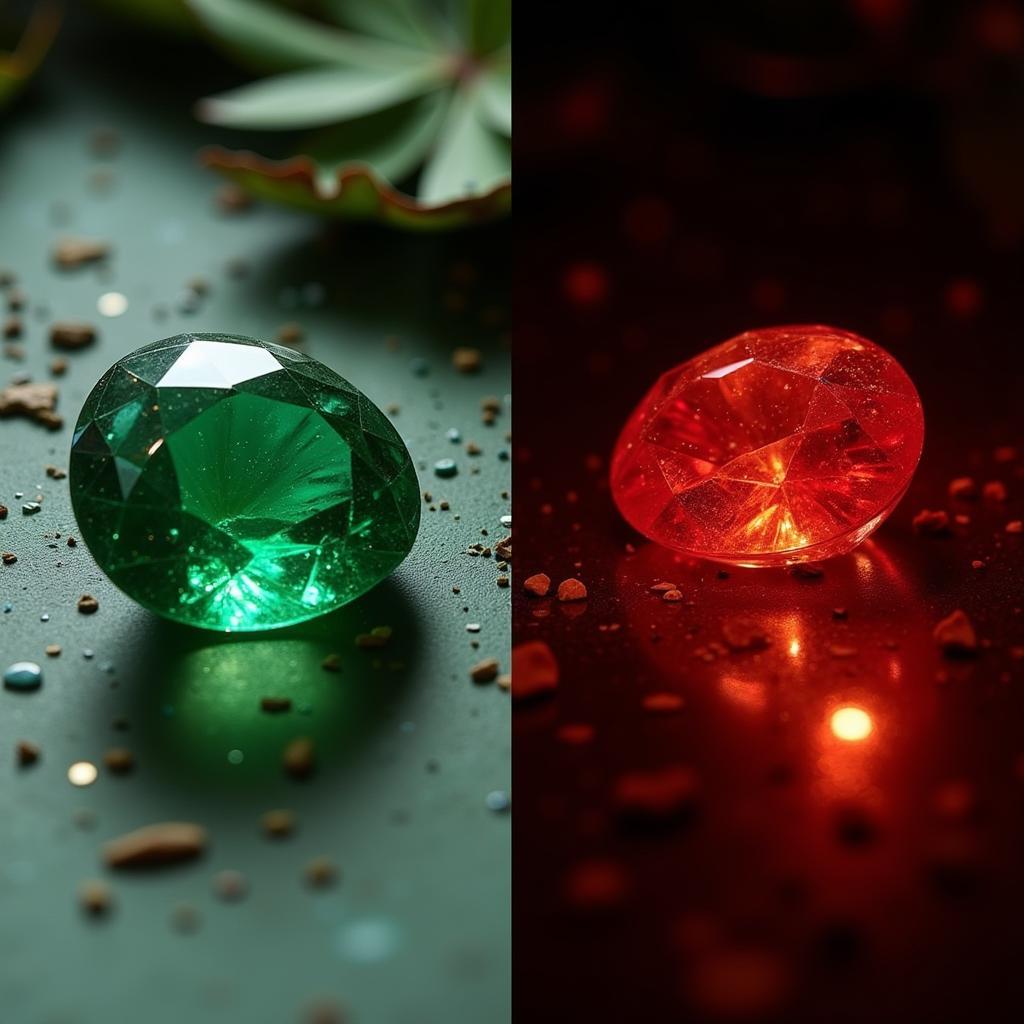Alexandrite, a fascinating gemstone, is known for its remarkable color-changing ability. This intriguing phenomenon, where the gem appears green in daylight and red under incandescent light, has captivated gem enthusiasts for centuries. But why does alexandrite change color? Let’s delve into the science behind this mesmerizing optical trick.
Alexandrite’s color-changing property, known as pleochroism, isn’t magic, but a fascinating interplay of light and the gem’s unique chemical composition. Specifically, it’s the presence of chromium within the crystal structure of chrysoberyl, the mineral family to which alexandrite belongs, that allows for this dramatic shift in color. The chromium ions absorb certain wavelengths of light, reflecting others back to our eyes. The type of light source—daylight versus incandescent—contains different wavelengths, leading to the perceived color change. This is what makes alexandrite so unique and highly prized. Imagine having a gem that seemingly transforms before your eyes!
Unveiling the Science Behind Alexandrite’s Color Change
Alexandrite’s color change stems from its unique ability to absorb different wavelengths of light depending on the light source. Daylight, rich in blue and green wavelengths, allows the chromium ions within the alexandrite to absorb red and yellow light, resulting in a vibrant green appearance. Conversely, incandescent light, which is richer in red and yellow wavelengths, allows the gem to absorb blue and green light, thus appearing red.
Want to learn more about how crystals get their color in general? You can find more information in our article on how do crystals get their color.
What Causes the Color Shift in Alexandrite?
The shift in color is not just a subtle change, but a dramatic transformation from a cool green to a warm, reddish hue. This is caused by the selective absorption and transmission of light wavelengths by the chromium ions. In essence, the chromium acts as a spectral filter, allowing certain colors to pass through while absorbing others. The specific proportions of these absorbed and transmitted wavelengths are what dictates the perceived color.
 Alexandrite Color Change in Daylight and Incandescent Light
Alexandrite Color Change in Daylight and Incandescent Light
Is Alexandrite Always Green and Red?
While the classic alexandrite color change is from green to red, variations exist. Some alexandrites might exhibit a yellowish-green in daylight and a purplish-red under incandescent light. These variations depend on the specific concentration of chromium and other trace elements within the gem.
Alexandrite: Beyond the Color Change
Beyond its mesmerizing color-changing ability, alexandrite is a durable and rare gemstone, making it a coveted addition to any jewelry collection. Its hardness, rated at 8.5 on the Mohs scale, makes it resistant to scratches and wear, perfect for everyday wear.
The Value and Rarity of Alexandrite
Alexandrite’s rarity and exceptional color-changing properties contribute to its high value. Larger, high-quality stones with a vivid color change are particularly prized. Understanding the factors that influence the color change adds another layer of appreciation for this exceptional gem.
Want to know the typical color of another birthstone? Check out our article on what is june’s birthstone color.
“Alexandrite is truly a remarkable gemstone,” says renowned gemologist, Dr. Elena Petrova. “Its color-changing property is a testament to the intricate wonders of nature and the fascinating interplay of light and chemistry.” Gem expert, James O’Connell, adds, “The rarity and beauty of alexandrite, combined with its durability, make it a highly sought-after gem for collectors and jewelry enthusiasts alike.”
In conclusion, alexandrite’s color change is a captivating phenomenon caused by the selective absorption and transmission of light by chromium ions within its crystal structure. This unique interaction with light, coupled with its rarity and durability, establishes alexandrite as a truly extraordinary gemstone. Understanding why does alexandrite change color enhances our appreciation for this mesmerizing gem.
FAQ
- What causes alexandrite to change color? The presence of chromium ions in its crystal structure.
- What are the typical colors of alexandrite? Green in daylight and red under incandescent light.
- Is alexandrite expensive? Yes, due to its rarity and unique properties.
- How can I tell if alexandrite is real? Consult a certified gemologist for proper identification.
- Is alexandrite durable? Yes, with a hardness of 8.5 on the Mohs scale.
- What is the June birthstone color? You can find more information in our dedicated article.
- Where can I buy genuine alexandrite? Reputable jewelers specializing in colored gemstones.
Need help with choosing the right color for your home? Contact us at Phone Number: 0373298888, Email: [email protected] Or visit us at: 86 Cau Giay, Hanoi. We have a 24/7 customer service team.

